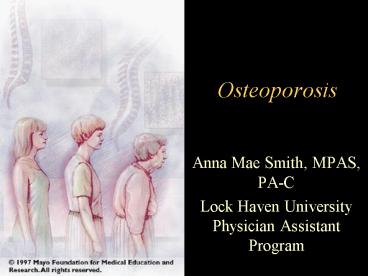Osteoporosis - PowerPoint PPT Presentation
1 / 27
Title:
Osteoporosis
Description:
Affects 25 million Americans. Causes more than 1 million ... Self-limited with cessation of fractures at puberty. Cause unknown. Types of Osteoporosis ... – PowerPoint PPT presentation
Number of Views:4961
Avg rating:3.0/5.0
Title: Osteoporosis
1
Osteoporosis
- Anna Mae Smith, MPAS, PA-C
- Lock Haven University Physician Assistant Program
2
Osteoporosis
- Affects 25 million Americans
- Causes more than 1 million fractures every year
in this country usually in the spine, hip or
wrist. - 1/2 of all Caucasian women age 50 and older can
expect to have a bone fracture due to
osteoporosis - 1/3 of men have some osteoporosis by age 75
3
Definition
- A multifactorial skeletal disease characterized
by severe bone loss and disruption of skeletal
micro-architecture sufficient to predispose to
atraumatic fractures of the - vertebral column
- upper femur
- distal radius
- proximal humerus
- pubic rami and ribs
4
Types of Osteoporosis
- Type I - Postmenopausal
- Type II - Involutional - occurs in both sexes
over 75 y/oA mixture of Type I II is common - Idiopathic - rare form of primary osteo. Cause
unknown, occurs in premenopausal women men(
prior to age 75)
5
Types of Osteoporosis
- Juvenile - A rare form of variable severity
occurring in prepubertal children. Self-limited
with cessation of fractures at puberty. Cause
unknown.
6
Types of Osteoporosis
- Secondary - due to extrinsic factors such as
- eating disorders
- steroid excess
- RA
- chronic liver/kidney disease
- malabsorption syndromes
- hyperparathyroidism
- hyperthyroidism
- hypogonadal states
- idiopathic hypercalciuria
7
Genetics
- Familial predisposition
- More common in Caucasians and Orientals than in
black and Latino ethnic groups
8
Incidence
- Elderly
- Females Males
- 30-40 cumulatively in women
- 5-15 in men
- Prevalence of idiopathic and juvenile types
unknown - Secondary osteoporosis cumulatively 5-10, both
sexes
9
Signs Symptoms
- Back ache/pain acute/chronic
- Kyphosis/scoliosis which leads to pot belly
- Atraumatic fractures
- No peripheral bone deformities
- Sclerae not blue/green/grey
- Loss of height
10
Etiology
- Postmenopausal (Type I) Hypoestrogenemia
- Involutional (Type II) Unknown
- Idiopathic Unknown
- Juvenile Unknown
- Secondary - see slide 5
11
Etiology
- Bone loss occurs with aging
- Osteoporosis occurs most frequently in
individuals who fail to achieve optimal skeletal
mass during development or lose bone rapidly
thereafter
12
Risk Factors
- Dietary -
- inadequate calcium
- excessive phosphate/protein
- inadequate vitamin D intake in the elderly
- Physical - immobilization, sedentary lifestyle
- Social - alcohol, cigarettes, caffeine
- Medical - chronic diseases, malabsorption,
endocrinopathies
13
Risk Factors
- Iatrogenic - corticosteroids, excess thyroid
hormone replacement, chronic heparin,
chemotherapy, loop diuretics, anticonvulsants,
radiation therapy, depro-provera, methotrexate,
GnRH agonists - Genetic/familial - suboptimal bone mass at
maturity, "familial fast bone losers"
14
Differential Diagnosis
- Multiple myeloma
- Other neoplasia
- Osteomalacia
- Osteogenesis imperfecta tarda (Type I)
- Skeletal hyperparathyroidism (primary and
secondary) - Hyperthyroidism
- Mastocytosis (rare)
15
Labs
- CBC - usually normal
- Alk Phosphatase - may be transiently increased
after a fracture - Serum /or urine protein
- TFTs urinary cortisol - normal in primary
types - Serum osteocalcin - if high, indicates high
turnover type - Urine calcium level
16
Pathological findings
- Reduced skeletal mass, trabecular bone more so
than cortical bone. Loss of trabecular
connections. - Osteoclast and osteoblast number variable
- No evidence of other metabolic bone diseases and
no increase in unmineralized osteoid - Marrow normal or atrophic
17
Imaging
- X-ray
- Bone scan
- Bone mineral density (BMD)
- most common is a DEXA scan - lumbar spine,
forearm upper femur
18
(No Transcript)
19
33 y/o
55 y/o
72 y/o
20
Treatment
- Pain - if a fracture occurs, Physical therapy
- May need to consider joint replacement
- Decrease falls
- Keep moving
21
Diet
- Weight - reduce if overweight
- Calcium 1500 mg/day
- 600-1000 IU of Vitamin D a day
- Avoid excess phosphate or protein intake certain
beverages with phosphoric acid
22
Drugs
- HRT
- Calcitonin (miacalcin nasal spray) or injections
- Fosamax Alendronate
- Actonel
- Didronel - inhibit bone resorption
- Evista/Raloxifene
- Miacalcin nasal spray
23
(No Transcript)
24
(No Transcript)
25
(No Transcript)
26
Prognosis
- 70 of patients stabilize skeletal
manifestations increase bone mass, increase
mobility, and have reduced pain - 20-30 of upper femoral fractures lead to chronic
care and/or premature death
27
- http//courses.washington.edu/bonephys/opmovies.ht
ml































